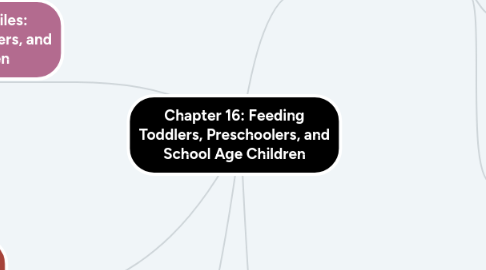
1. Developmental Profiles: Toddlers, Preschoolers, and School- Age Children
1.1. Toddlers (1-3): Serve small amounts of food, more often
1.1.1. Toddlers are typically not open to trying new foods- neophobic. Which is the fear of trying new or unknown things.
1.2. Preschool Age Children (2 1/2 -6): Easy going and cooperative
1.3. School- Age Children: Aware of everything around them. Eager to learn.
1.4. Meal practices- cultural eating habits and food preferences are very important.
2. Promoting Healthy Eating Habits
2.1. Between the ages of 1-5 are important because lifelong eating patterns are established.
2.2. Children need to establish good eating habits. Kids watch their parents, teacher and peers eat so it is good to make sure you are representing healthy eating.
3. Health Problems Related to Eating Habits
3.1. Tooth Decay, Obesity, High blood pressure, etc.
4. The Challenges of Feeding Toddlers
4.1. What Foods Should Be Served and How Much
4.1.1. Toddlers should be served less than what they are required to eat so they can request more and they don't get overwhelmed.
4.1.2. Families and teachers are the ones who should be serving children a wide variety of different nutritious foods.
4.1.3. Milk: 1/2 cup, Meat: 1 ounce, Fruit: 1/4 to 1/2 cup, Vegetables: 1/4 to 1/2 cup, Grains: 1/4 cup of "rice", 1/2 cup cereal, 1/2 slice of bread
4.1.4. A toddlers acceptance to food is influenced greatly on their senses- mainly, texture, temperature, and taste.
4.2. When to Serve Food
4.2.1. Warn the child so they can get prepared to eat. Also, make sure the child isn't too tired.
4.2.2. Breakfast, midmorning snack, lunch, mid afternoon snack, dinner, bedtime snack
4.3. Making Mealtime Comfortable, Pleasant and Safe
4.3.1. Furniture should fit the child's size
4.3.2. Children eat better when they feel comfortable.
4.3.3. Children's forks should be short, blunt, broad, easy to grip, etc.
4.3.4. Give them foods that will work good with utensils so they are encouraged to use them and it works.
4.3.5. Meat and Cheese: small cubes, Veggies and Fruit: small pieces
5. The Challenges of Feeding Preschoolers and School- Age Children
5.1. Guidelines For Feeding the Preschooler
5.1.1. Milk: 3/4 cup, Meat: 1 1/2 ounces, Fruit and Vegetables: 1/2 cup, Grains, 1/4 cup pasta, 1/2 cup cereal, 1/2 slice of bread
5.1.2. Willingness to eat is based on the child's sensory qualities as well
5.1.3. Having a comfortable environment is essential
5.2. Nutrient Needs of School Age Children
5.2.1. A well balanced diet is important and critical
5.2.2. Milk: 1 cup, Meat: 2 ounces, Fruits/ Veggies: 1/2 to 3/4 cup, Grains: 1 cup cereal, 1 slice of bread, 1/2 cup rice
5.3. Feeding Children who have Special Needs
5.3.1. Depending on the disability, different things should be watched. Such as food intake, nutrient intake, etc.

